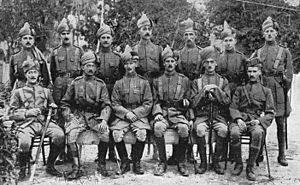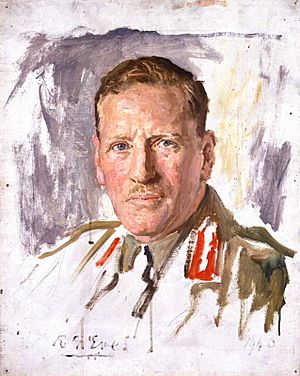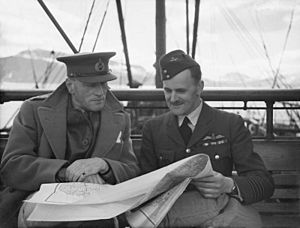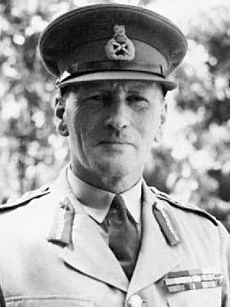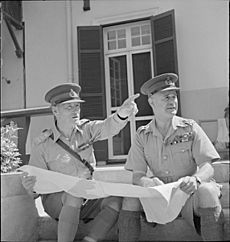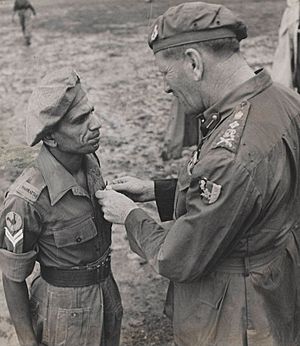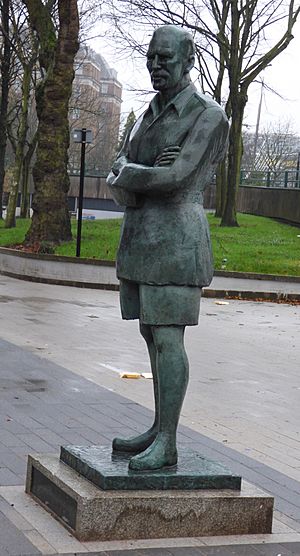Claude Auchinleck facts for kids
Quick facts for kids
Claude Auchinleck
|
|
|---|---|

Portrait by Cecil Beaton, c. 1945
|
|
| Nickname(s) | The Auk |
| Born | 21 June 1884 Aldershot, Hampshire, England |
| Died | 23 March 1981 (aged 96) Marrakech, Morocco |
| Allegiance | United Kingdom |
| Service/ |
British Indian Army |
| Years of service | 1904–1947 |
| Rank | Field marshal |
| Commands held | Supreme Commander India and Pakistan (1947–1948) Commander-in-Chief, India (1941, 1943–1947) Middle East Command (1941–1942) Southern Command (1940) V Corps (1940) Commander-in-chief, Northern Norway (1940) IV Corps (1940) 3rd Indian Infantry Division (1939) Meerut district (1938) Peshawar Brigade (1933–1936) 1st Battalion, 1st Punjab Regiment (1929–1930) |
| Battles/wars | |
| Awards |
|
| Other work |
Colonel 1st Battalion 1st Punjab Regiment (January 1933)
|
Field Marshal Sir Claude John Eyre Auchinleck (born 21 June 1884 – died 23 March 1981) was a very important British Army leader during the Second World War. He spent most of his military career in India. There, he became the Commander-in-Chief of the Indian Army in 1941.
Later, in July 1941, he was put in charge of the Middle East forces. But the war in North Africa became very tough for the British. He was replaced in 1942 during the North African campaign. In June 1943, he was again made Commander-in-Chief, India. He helped a lot by organizing supplies and training for William Slim's Fourteenth Army. This was key to their success. He stayed in this role until India became independent in 1947. After that, he was Supreme Commander of all British forces in India and Pakistan until 1948.
Contents
Early Life and Military Start
Claude Auchinleck was born in Aldershot, England. He went to Eagle House School and Wellington College with scholarships. After studying at the Royal Military College, Sandhurst, he joined the Indian Army in 1903.
He quickly learned several Indian languages. This helped him talk easily with his soldiers. He also learned about their local ways and customs. This made his soldiers respect him a lot. He was promoted to lieutenant in 1905. He spent time in Tibet and Sikkim before becoming a captain in 1912.
Fighting in World War I
Auchinleck fought in the First World War. His regiment was sent to protect the Suez Canal in Egypt. In February 1915, he fought against the Turks at Ismaïlia. His unit then moved to Aden to stop another Turkish threat.
In December 1915, his division landed in Basra for the Mesopotamian campaign. He became an acting major in July 1916. He took part in tough battles against the Turks at Battle of Hanna in January 1916. He was one of the few British officers in his regiment to survive these fights.
He led his battalion in February 1917. He fought in the Second Battle of Kut and the Fall of Baghdad. For his bravery, he received the Distinguished Service Order in 1917. He was promoted to major in 1918.
Between the Big Wars
After World War I, Auchinleck studied at the Staff College, Quetta. In 1921, he married Jessie Stewart. They did not have any children.
He continued to rise through the ranks. He became a lieutenant-colonel in 1929. He then commanded his regiment, which was now called the 1st Punjab Regiment. In 1930, he became a full colonel. He also taught at the Staff College, Quetta.
In 1933, he was promoted to temporary brigadier. He led the Peshawar Brigade. This unit helped bring peace to tribal areas. He led another mission in 1935. For his work, he was promoted to major-general in 1935.
In 1938, Auchinleck led a committee. Its job was to make the British Indian Army more modern. Their ideas helped the Indian Army grow a lot. It went from 183,000 soldiers in 1939 to over 2.25 million by the end of the war.
World War II Leadership
Fighting in Norway (1940)
When World War II began, Auchinleck was put in charge of the Indian 3rd Infantry Division. In January 1940, he was called to the United Kingdom. He commanded IV Corps. This was special because he was an Indian Army officer leading a British corps.
In May 1940, Auchinleck took command of British and French ground forces in the Norwegian campaign. This mission was very difficult and ended in failure.
Back to India and Iraq (1941)
In January 1941, Auchinleck was called back to India. He became the Commander-in-Chief, India. He also became an important advisor to the King.
In April 1941, an air base in Iraq was in danger. Auchinleck quickly sent soldiers to help. He sent one battalion by air and a whole division by sea. His quick actions helped end the Anglo-Iraqi War quickly.
Challenges in North Africa (1941–1942)
In July 1941, Auchinleck became Commander-in-Chief of the Middle East Command. He was in charge of forces in North Africa, Persia, and the Middle East. He launched an attack in the Western Desert in November 1941. This was called Operation Crusader.
Even though there were some setbacks, his forces pushed the enemy back. He believed the enemy was defeated. But the enemy, led by Rommel, attacked again. They pushed the British back towards Egypt.
In May 1942, Rommel attacked at the Battle of Gazala. This was a big defeat for the British. Tobruk fell to the enemy in June 1942.
On June 24, Auchinleck took direct command of the Eighth Army. He decided to pull back to a stronger defensive position at El Alamein. Here, he stopped the tired German and Italian forces in the First Battle of El Alamein.
However, Auchinleck had some problems with his senior commanders. They sometimes argued, and he was criticized for not understanding British and Dominion troops well. Prime Minister Churchill wanted a victory very badly. He put a lot of pressure on Auchinleck. In August 1942, Churchill replaced him with General Sir Harold Alexander.
Some historians, like Joseph M. Horodyski, believe Auchinleck was a very good leader. They say he played the biggest part in defending El Alamein. This helped defeat Rommel in Africa later.
Back in India (1942–1945)
Churchill offered Auchinleck another command, but he turned it down. He believed it was not a good idea. Instead, he returned to India. In June 1943, he was again made Commander-in-Chief of the Indian Army.
His job was to keep India safe and build it up as a base for the war. He reorganized the Indian Army. He also trained forces for the South East Asia Command. He made sure supplies reached the front lines.
During this time, Auchinleck faced personal difficulties. His marriage ended in divorce in 1946. This affected him deeply.
India's Partition and Later Years
Auchinleck stayed as Commander-in-Chief of the Indian Army after the war. He helped prepare the future Indian and Pakistani armies for the Partition of India. He did this even though he disagreed with the idea of dividing India. In 1945, he had to change some harsh sentences for soldiers of the Indian National Army. This was because people in India were very upset.
On June 1, 1946, he was promoted to field marshal. He refused a special title (a peerage) because he didn't want to be linked to the Partition. He thought it was a dishonorable plan.
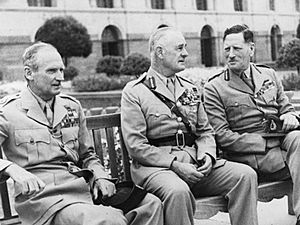
In September 1947, Auchinleck wrote a report to the British Government. He said that Indian leaders were trying to stop Pakistan from becoming strong. He noted that they were trying to block the division of the armed forces.
When India was divided in August 1947, Auchinleck became Supreme Commander of all British forces in India and Pakistan. He stayed in this role until November 1947. This was his effective retirement from the army. He left India on December 1.
After retiring, Auchinleck lived in London for a while. He worked with charities and businesses. He also became a good watercolor painter. In 1960, he moved to Beccles in Suffolk. Seven years later, at age eighty-four, he moved to Marrakesh, Morocco. He died there on March 23, 1981.
Memorials
Claude Auchinleck is buried in Ben M'Sik European Cemetery in Casablanca. This cemetery is looked after by the Commonwealth War Graves Commission.
There is a memorial plaque for him in St Paul's Cathedral in London. You can also see a bronze statue of Auchinleck in Birmingham, England.
Awards and Honors
- Knight Grand Cross of the Order of the Bath (1945)
- Companion of the Order of the Bath (1934)
- Knight Grand Commander of the Order of the Indian Empire (1940)
- Companion of the Order of the Star of India (1936)
- Distinguished Service Order (1917)
- Officer of the Order of the British Empire (1919)
- Mention in Despatches (three times)
- Croix de Guerre with Palm (France, 1918 and 1949)
- Chief Commander of the Legion of Merit (United States, 1948)
- Virtuti Militari, 5th class (Poland, 1942)
- Member First Class Order of the Star of Nepal (Nepal)
- War Cross (Czechoslovakia, 1944)
- Knight Grand Cross of Order of St Olav (Norway, 1948)
See also
 In Spanish: Claude Auchinleck para niños
In Spanish: Claude Auchinleck para niños


